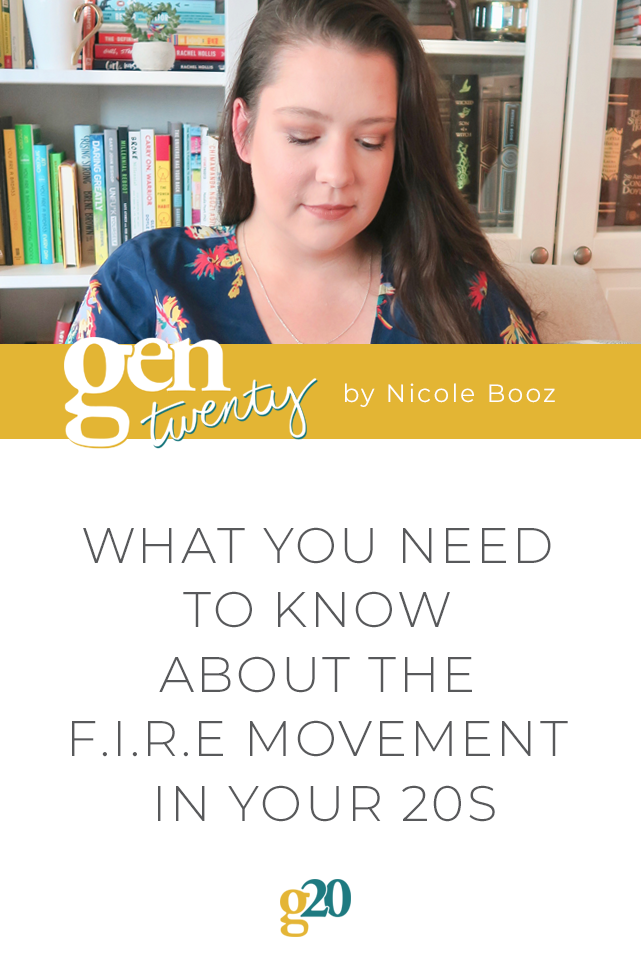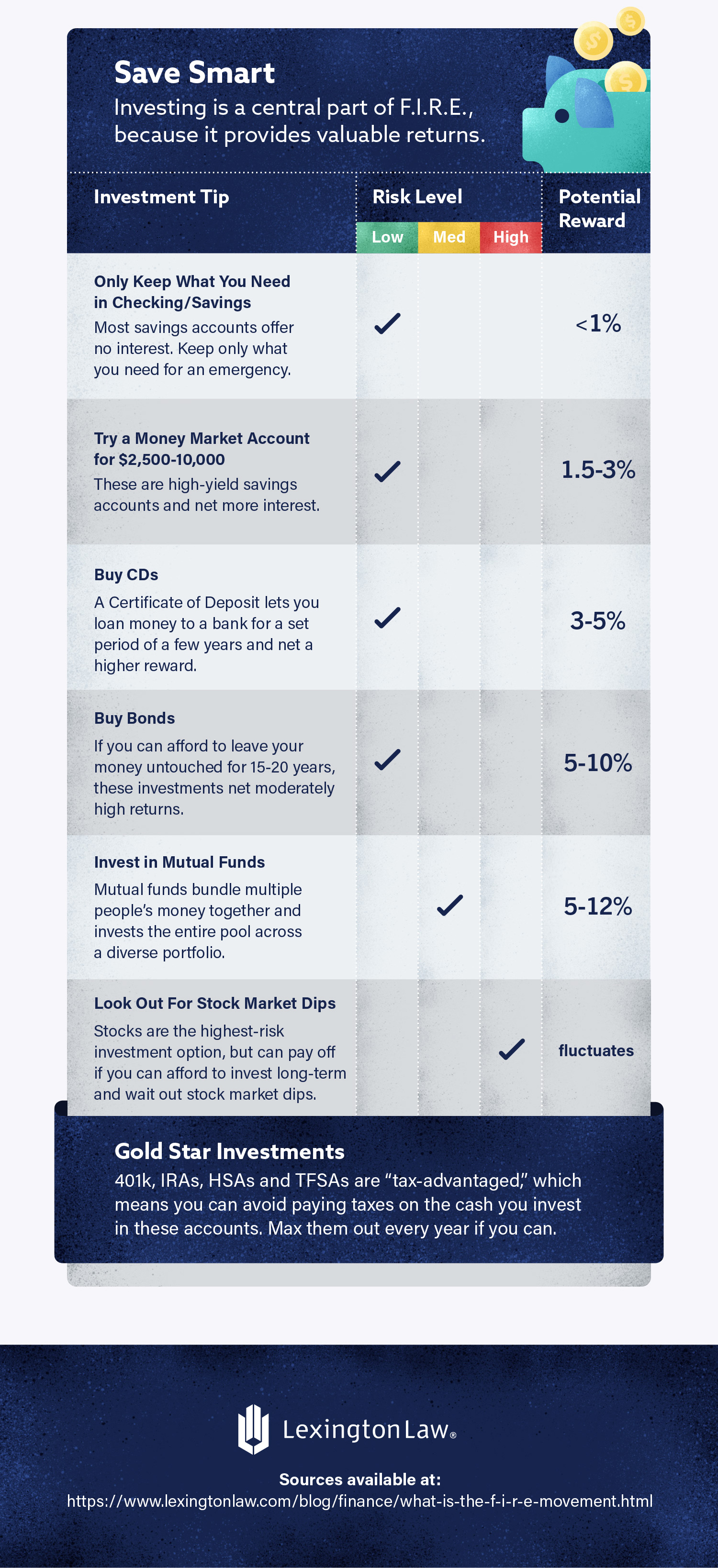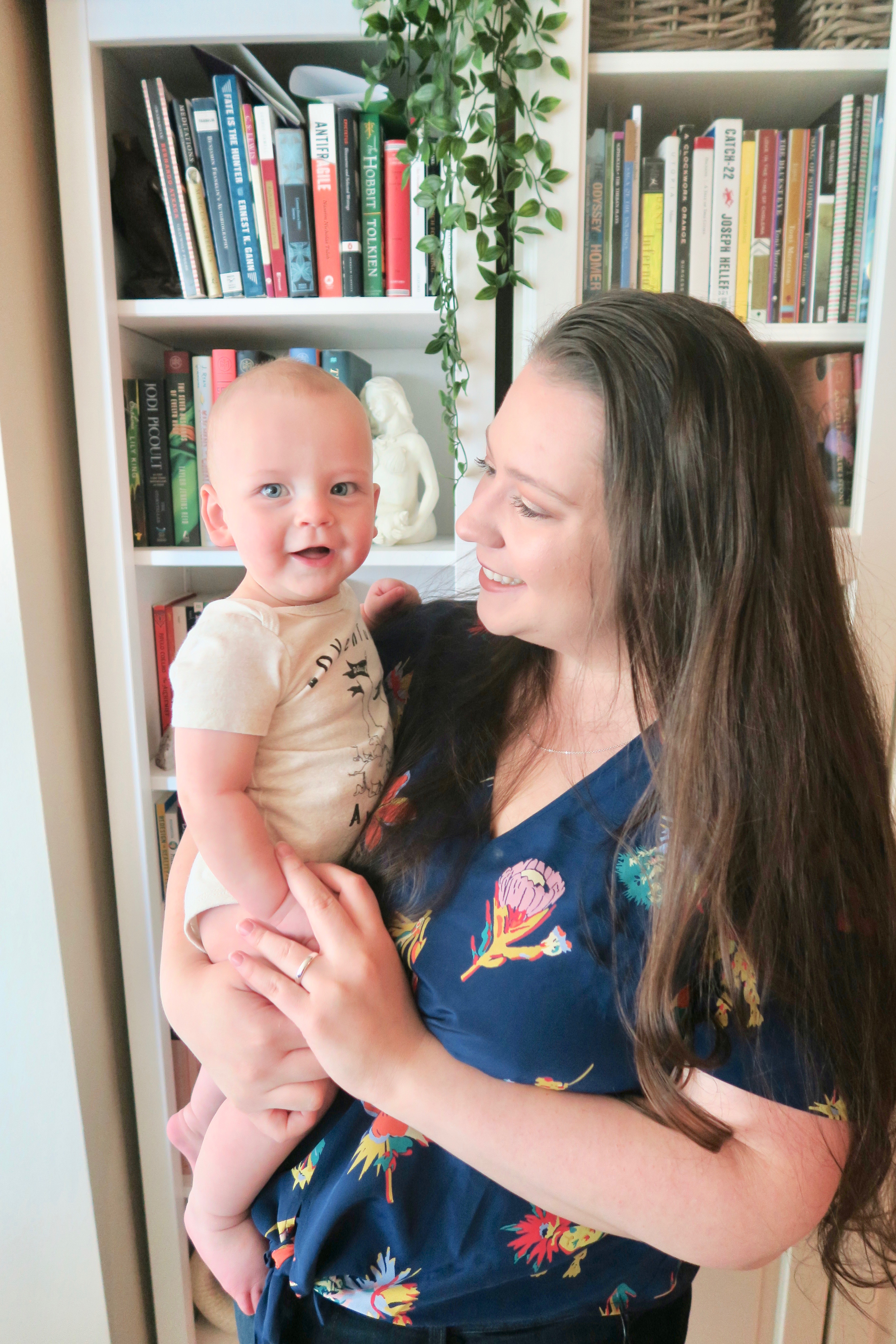This post is sponsored by Lexington Law.

Have you heard of the F.I.R.E movement? No, it’s not for candle enthusiasts as the name may suggest. F.I.R.E stands for financial independence, retire early. The idea is that if you can grow your investments to 25 times your annual spending you’ll no longer need to have an income to live comfortably.
As an example, let’s say you live comfortably on $40,000 a year. Multiply that by 25 and you’ll need $1,000,000 in savings to retire early.
Financial independence means living off of the returns of your investment accounts. You’re not dependent on a salary or income to cover your annual expenses. The idea is that you’ll withdraw 4 percent of your portfolio every year and life off of that amount. For F.I.R.E to work, strategists say to aim for an annual return of at least 5 percent.
So now that we know what the F.I.R.E movement is, how in the world are people actually achieving this?

The 3 Lifestyle Changes That Support F.I.R.E
Essentially, there are three main things people do to achieve financial independence and retire early: lower your annual spending, increase your income, and invest.
1. Lowering your annual spending.
This makes sense, right? Lowering your spending means lowering the amount you need to withdrawal every year, which in turn, means you need less to start with.
So how low do you need to go? Well, the F.I.R.E movement founder suggests cutting spending down to less than $10,000 per adult in your family each year.
If that seems challenging, it’s because it is.
Many people who are chasing F.I.R.E practice extreme frugality. They aren’t just cutting cable or reusing teabags. The do things like grow their own food and make their own laundry detergent. They might not use electricity after a certain hour in the day. They might even relocate to another town with a much lower cost of living to save money.
This drastic reduction in lifestyle and expenses gives you freedom from having to work to support yourself and/or your family. You can use your time for other things like traveling, reduce the stress in your life, spend more time with family, spend time on your hobbies or for health reasons.

Here are some other suggestions to help you save money to reach your F.I.R.E goals:
- cut out drinks like soda or sparkling water in favor of tap water
- use only your own reusable water bottle
- pack all lunches or cut down on eating out to once per week
- change cable providers or cut it out all together
- negotiate your wifi bill
- use the library (or the Libby app) for access to free books and entertainment
- have movie nights at home instead of going out
- use a bike instead of a car or become a one car family
- meal plan to reduce food waste (and also to prevent wasting money)
- make your own cold brew at home instead of purchasing coffees out
- take advantage of “free” things like food samples and local events
Going back to the idea of living on less than $10k per year, how does that stack up to your current spending? What would you have to change to be able to live off of that amount?
For me, I’d have to make a lot of changes to make that possible but there are probably at least a few things I can change starting right now to make a difference.
2. Increase your income.
So beyond cutting back your spending, the next part of the F.I.R.E formula is increasing your income.
This is key for many people because they need to increase their income to reach their investment goals in order to retire early and have financial independence. Going back to that first example, you’d need $1,000,000 in investments to live off of $40k/year.
However, saving that amount of money on a $50k/year salary isn’t really possible. That’s why increasing your income is so important.
Lexington Law says to consider that there are three types of income:
- Passive: income from work in which a person is not actively involved
- Earned: income from paid work (also known as “active” income)
- Portfolio: income from investments, dividends, interest, and capital gains
Making more money as a lot of benefits, including:
- financial freedom
- financial security
- less debt (and more money to put towards debt repayment)
- building up your savings account
- more money to put towards retirement
- less stress in your daily life
- the ability to improve your credit (and your life)
Making money passively allows you to earn more money and therefore save more money without needing to spend time doing so (like you would at a 9-5 job). Passive income is an excellent way to help you sock away more money into your investment accounts (or pay off debt first).
A few weeks back, I created the ultimate guide to making more money that includes strategies like side hustles, negotiating a raise, changing jobs, finding “hidden income,” and maximizing your dollars. Check it out even if F.I.R.E doesn’t seem up your alley — there are plenty of benefits to making more money even without retiring early.

3. Invest, invest, invest.
So the thing that makes F.I.R.E work at all is that you have invested your money enough to live off of the annual returns. Which obviously means that you’ll need an investment strategy that considers that.
There are different types of investment accounts that work differently and have different return rates. But it also depends on your level of risk for what strategy will work best for you.
Our friends at Lexington Law have put together this fantastic infographic with investment account information:

To help you get started, we also have an entire series on investing that can help get you familiar with investing terms and strategies:
- Investing 101: A Beginner’s Guide To Investing For Wealth
- 7 Times When Investing Isn’t The Smartest Financial Move
- 6 Things To Do Before You Start Investing
- 10 Investing Myths Busted
The bottom line with investing is that the sooner you get started, the better. Time is what helps your money to grow and you’ll never have as much time again as you do right now.
What Else The F.I.R.E Movement Considers
So once you’ve decided on your F.I.R.E strategy and goals, there are a few other things to consider as well:
1. An excellent credit score.
If you’re not bringing in any income and expecting to live off of the returns on your investment accounts, your credit score will matter.
It will matter for where you live, whether that’s a house or an apartment. Your credit score will matter if you need to buy a new-to-you car. It’ll matter if you need to take out a loan or line of credit for any reason, including a new credit card. As a general rule of thumb, the higher your credit score, the lower your interest rate will be. And this can really matter if you’re on a strict budget due to early retirement.
If you haven’t already started trying to improve your credit score, here is a list of things you can start doing in the next six months to improve your credit score.
If you’ve checked your credit report and you’re not familiar with everything on it, that’s a red flag. If you do come across unfair negative items, I suggest reaching out to the credit repair professionals at Lexington Law for a credit repair consultation. Fixing your credit isn’t something you want to put off.
2. Health insurance.
When you’re traditionally employed, usually your health insurance is through your employer. Even for those who are self-employed (like myself), health insurance might come from a spouse’s traditional employment.
If you’re retiring early, health insurance is something you’ll need to factor into your monthly expenses. Search around for various quotes to find one that best suits your health needs (including prevention) so that you won’t have to pay out of pocket for these expenses.

3. Where you’ll live.
Many people who F.I.R.E live in low cost of living areas. They are able to not only save more money this way on their living expenses but can keep their expenses low once they no longer have earned income.
If plan to live in a house you own, make sure you take into account property taxes and other fees associated with your living arrangements. If you’re renting, make sure you adjust for inflation for years to come.
4. An emergency fund.
Does F.I.R.E allow for emergencies? When you’re living on such a lower income, like $10,000 annually (which is only $833/month, by the way) you don’t have much leftover in case something happened like needing a last minute plane ticket or a trip to the emergency room.
This is where an emergency fund comes in. Now, if you’re planning to retire early, what you would need saved in an easily accessible, liquid savings account would be totally different than what a family of five with two incomes and student loan debt would need.
I’ve put together a guide for figuring out how much you need in your emergency fund. Whether you are deciding to F.I.R.E or not, I think an emergency fund is a financial must-have.
5. Your debt.
If you’re hoping to achieve financial independence, you’ll want to pay off your debt as quickly as possible. It’s not reasonable to include your debt repayment in your annual expenses. Partially because the interest rate on your debt is accumulating a lot faster than the interest is on your investments. It’s a better strategy to pay off any debt you have as quickly as possible before getting rid of your earned income.
Related: The Ultimate Guide To Overcoming Student Loan Debt
So now that you know what the F.I.R.E movement is — what do you think? Does it sound desirable to you?
For me personally, I can say that it would be nice to know that I had at least enough income to cover my basic expenses from my portfolio but also that I had some passive income on the side to bolster my earned income. I’m not sure I want to fully retire early, I do actually like working, after all. And to be honest, living on $10k a year is not quite my speed. But I think that’s a topic for another post.
I’d love to know what aspects of F.I.R.E most appeal to you — let me know in the comments!
